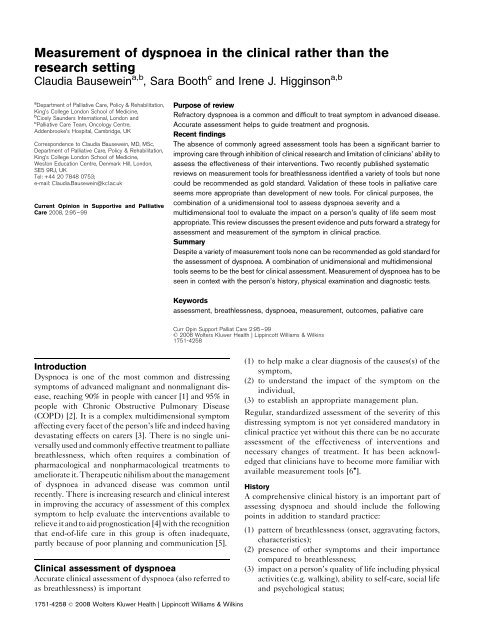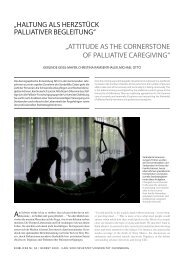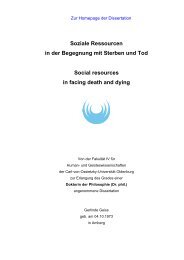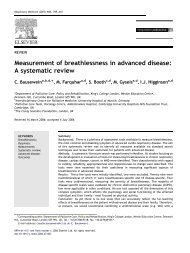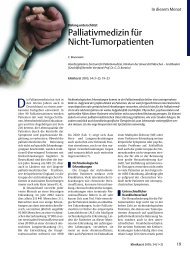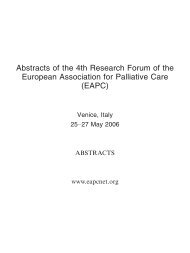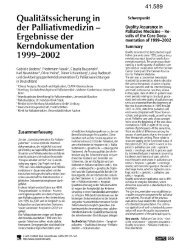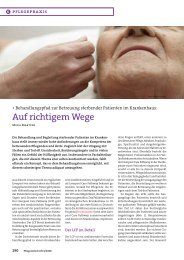Measurement of dyspnoea in the clinical rather than the ... - ipac
Measurement of dyspnoea in the clinical rather than the ... - ipac
Measurement of dyspnoea in the clinical rather than the ... - ipac
Create successful ePaper yourself
Turn your PDF publications into a flip-book with our unique Google optimized e-Paper software.
<strong>Measurement</strong> <strong>of</strong> <strong>dyspnoea</strong> <strong>in</strong> <strong>the</strong> cl<strong>in</strong>ical ra<strong>the</strong>r <strong>than</strong> <strong>the</strong><br />
research sett<strong>in</strong>g<br />
Claudia Bausewe<strong>in</strong> a,b , Sara Booth c and Irene J. Higg<strong>in</strong>son a,b<br />
a Department <strong>of</strong> Palliative Care, Policy & Rehabilitation,<br />
K<strong>in</strong>g’s College London School <strong>of</strong> Medic<strong>in</strong>e,<br />
b Cicely Saunders International, London and<br />
c Palliative Care Team, Oncology Centre,<br />
Addenbrooke’s Hospital, Cambridge, UK<br />
Correspondence to Claudia Bausewe<strong>in</strong>, MD, MSc,<br />
Department <strong>of</strong> Palliative Care, Policy & Rehabilitation,<br />
K<strong>in</strong>g’s College London School <strong>of</strong> Medic<strong>in</strong>e,<br />
Weston Education Centre, Denmark Hill, London,<br />
SE5 9RJ, UK<br />
Tel: +44 20 7848 0753;<br />
e-mail: Claudia.Bausewe<strong>in</strong>@kcl.ac.uk<br />
Current Op<strong>in</strong>ion <strong>in</strong> Supportive and Palliative<br />
Care 2008, 2:95–99<br />
Purpose <strong>of</strong> review<br />
Refractory <strong>dyspnoea</strong> is a common and difficult to treat symptom <strong>in</strong> advanced disease.<br />
Accurate assessment helps to guide treatment and prognosis.<br />
Recent f<strong>in</strong>d<strong>in</strong>gs<br />
The absence <strong>of</strong> commonly agreed assessment tools has been a significant barrier to<br />
improv<strong>in</strong>g care through <strong>in</strong>hibition <strong>of</strong> cl<strong>in</strong>ical research and limitation <strong>of</strong> cl<strong>in</strong>icians’ ability to<br />
assess <strong>the</strong> effectiveness <strong>of</strong> <strong>the</strong>ir <strong>in</strong>terventions. Two recently published systematic<br />
reviews on measurement tools for breathlessness identified a variety <strong>of</strong> tools but none<br />
could be recommended as gold standard. Validation <strong>of</strong> <strong>the</strong>se tools <strong>in</strong> palliative care<br />
seems more appropriate <strong>than</strong> development <strong>of</strong> new tools. For cl<strong>in</strong>ical purposes, <strong>the</strong><br />
comb<strong>in</strong>ation <strong>of</strong> a unidimensional tool to assess <strong>dyspnoea</strong> severity and a<br />
multidimensional tool to evaluate <strong>the</strong> impact on a person’s quality <strong>of</strong> life seem most<br />
appropriate. This review discusses <strong>the</strong> present evidence and puts forward a strategy for<br />
assessment and measurement <strong>of</strong> <strong>the</strong> symptom <strong>in</strong> cl<strong>in</strong>ical practice.<br />
Summary<br />
Despite a variety <strong>of</strong> measurement tools none can be recommended as gold standard for<br />
<strong>the</strong> assessment <strong>of</strong> <strong>dyspnoea</strong>. A comb<strong>in</strong>ation <strong>of</strong> unidimensional and multidimensional<br />
tools seems to be <strong>the</strong> best for cl<strong>in</strong>ical assessment. <strong>Measurement</strong> <strong>of</strong> <strong>dyspnoea</strong> has to be<br />
seen <strong>in</strong> context with <strong>the</strong> person’s history, physical exam<strong>in</strong>ation and diagnostic tests.<br />
Keywords<br />
assessment, breathlessness, <strong>dyspnoea</strong>, measurement, outcomes, palliative care<br />
Curr Op<strong>in</strong> Support Palliat Care 2:95–99<br />
ß 2008 Wolters Kluwer Health | Lipp<strong>in</strong>cott Williams & Wilk<strong>in</strong>s<br />
1751-4258<br />
Introduction<br />
Dyspnoea is one <strong>of</strong> <strong>the</strong> most common and distress<strong>in</strong>g<br />
symptoms <strong>of</strong> advanced malignant and nonmalignant disease,<br />
reach<strong>in</strong>g 90% <strong>in</strong> people with cancer [1] and 95% <strong>in</strong><br />
people with Chronic Obstructive Pulmonary Disease<br />
(COPD) [2]. It is a complex multidimensional symptom<br />
affect<strong>in</strong>g every facet <strong>of</strong> <strong>the</strong> person’s life and <strong>in</strong>deed hav<strong>in</strong>g<br />
devastat<strong>in</strong>g effects on carers [3]. There is no s<strong>in</strong>gle universally<br />
used and commonly effective treatment to palliate<br />
breathlessness, which <strong>of</strong>ten requires a comb<strong>in</strong>ation <strong>of</strong><br />
pharmacological and nonpharmacological treatments to<br />
ameliorate it. Therapeutic nihilism about <strong>the</strong> management<br />
<strong>of</strong> <strong>dyspnoea</strong> <strong>in</strong> advanced disease was common until<br />
recently. There is <strong>in</strong>creas<strong>in</strong>g research and cl<strong>in</strong>ical <strong>in</strong>terest<br />
<strong>in</strong> improv<strong>in</strong>g <strong>the</strong> accuracy <strong>of</strong> assessment <strong>of</strong> this complex<br />
symptom to help evaluate <strong>the</strong> <strong>in</strong>terventions available to<br />
relieve it and to aid prognostication [4] with <strong>the</strong> recognition<br />
that end-<strong>of</strong>-life care <strong>in</strong> this group is <strong>of</strong>ten <strong>in</strong>adequate,<br />
partly because <strong>of</strong> poor plann<strong>in</strong>g and communication [5].<br />
Cl<strong>in</strong>ical assessment <strong>of</strong> <strong>dyspnoea</strong><br />
Accurate cl<strong>in</strong>ical assessment <strong>of</strong> <strong>dyspnoea</strong> (also referred to<br />
as breathlessness) is important<br />
(1) to help make a clear diagnosis <strong>of</strong> <strong>the</strong> causes(s) <strong>of</strong> <strong>the</strong><br />
symptom,<br />
(2) to understand <strong>the</strong> impact <strong>of</strong> <strong>the</strong> symptom on <strong>the</strong><br />
<strong>in</strong>dividual,<br />
(3) to establish an appropriate management plan.<br />
Regular, standardized assessment <strong>of</strong> <strong>the</strong> severity <strong>of</strong> this<br />
distress<strong>in</strong>g symptom is not yet considered mandatory <strong>in</strong><br />
cl<strong>in</strong>ical practice yet without this <strong>the</strong>re can be no accurate<br />
assessment <strong>of</strong> <strong>the</strong> effectiveness <strong>of</strong> <strong>in</strong>terventions and<br />
necessary changes <strong>of</strong> treatment. It has been acknowledged<br />
that cl<strong>in</strong>icians have to become more familiar with<br />
available measurement tools [6 ].<br />
History<br />
A comprehensive cl<strong>in</strong>ical history is an important part <strong>of</strong><br />
assess<strong>in</strong>g <strong>dyspnoea</strong> and should <strong>in</strong>clude <strong>the</strong> follow<strong>in</strong>g<br />
po<strong>in</strong>ts <strong>in</strong> addition to standard practice:<br />
(1) pattern <strong>of</strong> breathlessness (onset, aggravat<strong>in</strong>g factors,<br />
characteristics);<br />
(2) presence <strong>of</strong> o<strong>the</strong>r symptoms and <strong>the</strong>ir importance<br />
compared to breathlessness;<br />
(3) impact on a person’s quality <strong>of</strong> life <strong>in</strong>clud<strong>in</strong>g physical<br />
activities (e.g. walk<strong>in</strong>g), ability to self-care, social life<br />
and psychological status;<br />
1751-4258 ß 2008 Wolters Kluwer Health | Lipp<strong>in</strong>cott Williams & Wilk<strong>in</strong>s
96 Respiratory problems<br />
(4) current symptomatic treatments for breathlessness<br />
(e.g. handheld fan) and <strong>the</strong>ir efficacy for that<br />
person;<br />
(5) adverse effects <strong>of</strong> any treatments used currently or <strong>in</strong><br />
<strong>the</strong> past;<br />
(6) all comorbidities;<br />
(7) <strong>the</strong> person’s understand<strong>in</strong>g and <strong>in</strong>terpretation <strong>of</strong><br />
<strong>the</strong> symptom.<br />
The carer’s psychological and social status, support available<br />
to <strong>the</strong>m and <strong>the</strong>ir hopes and fears about <strong>the</strong> condition<br />
need separate assessment as <strong>the</strong>se will have a<br />
significant effect on <strong>the</strong> patient’s condition.<br />
It is particularly important to dist<strong>in</strong>guish whe<strong>the</strong>r <strong>the</strong><br />
underly<strong>in</strong>g cause <strong>of</strong> breathlessness is irreversible or<br />
potentially reversible. Any recent or acute escalation <strong>of</strong><br />
breathlessness may <strong>in</strong>dicate a new potentially treatable<br />
disorder (e.g. pulmonary emboli) or exacerbation <strong>of</strong> <strong>the</strong><br />
underly<strong>in</strong>g condition, for example COPD, or escalation<br />
<strong>of</strong> underly<strong>in</strong>g disease (e.g. <strong>in</strong>terstitial lung disease) <strong>in</strong>dicat<strong>in</strong>g<br />
<strong>the</strong> need for end-<strong>of</strong>-life care or an alteration <strong>in</strong> <strong>the</strong><br />
treatment regimen.<br />
Verbal descriptors <strong>of</strong> <strong>dyspnoea</strong><br />
Dyspnoea comprises a number <strong>of</strong> qualitatively different<br />
sensations [7] and attempts have been made to l<strong>in</strong>k<br />
descriptors <strong>of</strong> breathlessness with dist<strong>in</strong>ct pathophysiological<br />
processes. This has been done with partial success<br />
<strong>in</strong> COPD [8 ] but not <strong>in</strong> cancer [9] <strong>in</strong> which a significant<br />
amount <strong>of</strong> overlap has been described between <strong>the</strong> same<br />
descriptors and different pathophysiologies. Thus, this<br />
l<strong>in</strong>e <strong>of</strong> enquiry may not be especially useful <strong>in</strong> ei<strong>the</strong>r<br />
cl<strong>in</strong>ical assessment or research.<br />
<strong>Measurement</strong> <strong>of</strong> <strong>dyspnoea</strong><br />
Dyspnoea is a subjective symptom so <strong>the</strong> person’s report<br />
<strong>of</strong> severity is <strong>the</strong> most accurate measure. Note however,<br />
this may be affected on a day-to-day basis by o<strong>the</strong>r factors<br />
(e.g. psychological or social changes) and ‘response shift’.<br />
Objective measures such as respiratory rate, oxygen<br />
saturation or lung function tests do not correlate with<br />
<strong>the</strong> subjective experience <strong>of</strong> people. The discrepancy<br />
between <strong>in</strong>tensity <strong>of</strong> breath<strong>in</strong>g discomfort and disease<br />
severity has been acknowledged [7]. Accurate measurement<br />
would differentiate between people with different<br />
levels <strong>of</strong> <strong>dyspnoea</strong> and capture changes result<strong>in</strong>g from<br />
treatment or over time [10].<br />
Numerous assessment tools are available for measur<strong>in</strong>g<br />
<strong>dyspnoea</strong>, but recent systematic reviews [11 ,12 ] have<br />
demonstrated that none can be regarded as a ‘gold<br />
standard’ achiev<strong>in</strong>g accurate, comprehensive assessment<br />
<strong>of</strong> <strong>dyspnoea</strong> <strong>in</strong> all sett<strong>in</strong>gs or for all diseases. Most have<br />
been validated <strong>in</strong> chronic respiratory illness, but not <strong>in</strong><br />
cancer or palliative care sett<strong>in</strong>gs [11 ] and fur<strong>the</strong>r validation<br />
is required. Select<strong>in</strong>g <strong>the</strong> most appropriate scale<br />
depends <strong>the</strong>refore on <strong>the</strong> context and purpose <strong>of</strong><br />
measurement [12 ].<br />
Essential <strong>in</strong>formation about measurement <strong>of</strong> <strong>dyspnoea</strong><br />
should <strong>in</strong>clude whe<strong>the</strong>r it was made dur<strong>in</strong>g or after<br />
exercise (<strong>the</strong> latter be<strong>in</strong>g carefully def<strong>in</strong>ed), <strong>the</strong> period<br />
over which <strong>the</strong> measurement was made (e.g. over last<br />
week, now or over last 24 h) and <strong>the</strong> severity <strong>of</strong> <strong>dyspnoea</strong><br />
at best, at worst and on average.<br />
<strong>Measurement</strong> tools for <strong>dyspnoea</strong><br />
The tools described <strong>in</strong> this review are those that seem<br />
most suitable for cl<strong>in</strong>ical practice. A wider overview <strong>of</strong> all<br />
available tools for measurement can be found <strong>in</strong> <strong>the</strong> two<br />
recently published systematic reviews [11 ,12 ].<br />
Unidimensional tools<br />
Three types <strong>of</strong> unidimensional <strong>in</strong>struments are commonly<br />
used <strong>in</strong> <strong>the</strong> measurement <strong>of</strong> <strong>dyspnoea</strong>: visual analogue<br />
scales (VASs), numerical rat<strong>in</strong>g scales (NRSs) and <strong>the</strong><br />
modified Borg scale. Unidimensional tools measure <strong>the</strong><br />
sensory component or general severity <strong>of</strong> breathlessness<br />
ei<strong>the</strong>r averaged over a period <strong>of</strong> time or at a po<strong>in</strong>t <strong>in</strong> time,<br />
for example after exercise. All unidimensional measures<br />
are self-adm<strong>in</strong>istered tak<strong>in</strong>g only a few moments to complete.<br />
Visual analogue scale<br />
The VAS is a horizontal or vertical l<strong>in</strong>e, usually 100-mm<br />
long that is widely used <strong>in</strong> <strong>the</strong> measurement <strong>of</strong> symptoms<br />
such as breathlessness and pa<strong>in</strong>, at a specific po<strong>in</strong>t <strong>in</strong><br />
time. A clear description <strong>of</strong> <strong>the</strong> sensation be<strong>in</strong>g measured<br />
must be given such as ‘breathlessness’, ‘distress due to<br />
breathlessness’ or ‘effort <strong>of</strong> breath<strong>in</strong>g’. Clear anchors are<br />
def<strong>in</strong>ed at each end <strong>of</strong> <strong>the</strong> VAS such as ‘not breathless at<br />
all’ to ‘extremely breathless’ or ‘not breathless’ to ‘breathlessness<br />
as bad as it can be’. The person <strong>in</strong>dicates a level<br />
<strong>of</strong> <strong>dyspnoea</strong> by mark<strong>in</strong>g <strong>the</strong> l<strong>in</strong>e between anchor po<strong>in</strong>ts<br />
and <strong>the</strong> distance from <strong>the</strong> left side or <strong>the</strong> bottom <strong>of</strong><br />
<strong>the</strong> scale is measured. As breathlessness is a sensation<br />
that can change between measurements, <strong>the</strong> VAS is most<br />
suited to with<strong>in</strong>-subject repeated measurement as it has<br />
<strong>the</strong> sensitivity required to measure m<strong>in</strong>ute changes [13]<br />
and has been shown to be reproducible <strong>in</strong> <strong>the</strong> same<br />
person on different days. It is nei<strong>the</strong>r suitable, however,<br />
for compar<strong>in</strong>g breathlessness <strong>in</strong> different people, nor<br />
would it be satisfactory for summariz<strong>in</strong>g or compar<strong>in</strong>g<br />
<strong>the</strong> conditions <strong>of</strong> groups <strong>of</strong> people [14].<br />
Numerical rat<strong>in</strong>g scale<br />
From pa<strong>in</strong> management it is known that NRSs are easier<br />
to use for people <strong>than</strong> VASs [15]. In <strong>the</strong> measurement <strong>of</strong><br />
breathlessness, rat<strong>in</strong>gs on <strong>the</strong> NRS are highly correlated
<strong>Measurement</strong> <strong>of</strong> <strong>dyspnoea</strong> <strong>in</strong> cl<strong>in</strong>ical sett<strong>in</strong>g Bausewe<strong>in</strong> et al. 97<br />
with VAS rat<strong>in</strong>gs [16]. The NRS has been shown to be a<br />
more repeatable measure <strong>than</strong> <strong>the</strong> VAS [17]. Healthy<br />
subjects preferred <strong>the</strong> NRS to <strong>the</strong> VAS dur<strong>in</strong>g exercise<br />
[18]. The NRS and Borg scales, unlike <strong>the</strong> VAS, can be<br />
used over <strong>the</strong> phone. In one study, <strong>the</strong> NRS was more<br />
repeatable <strong>than</strong> <strong>the</strong> VAS <strong>in</strong> participants with cancer<br />
[17].<br />
Modified Borg scale<br />
The modified Borg scale is a categorical scale similar to a<br />
NRS but descriptive terms (severe, moderately severe,<br />
etc.) are used to anchor responses [19]. The modified<br />
Borg scale has ratio properties [20] but is not strictly l<strong>in</strong>ear<br />
[21]. It is possible that larger changes are more likely to be<br />
observed at <strong>the</strong> higher end <strong>of</strong> <strong>the</strong> scale <strong>in</strong> which <strong>the</strong>re are<br />
larger numerical <strong>in</strong>tervals between word anchors for<br />
symptom severity [21]. Modified Borg scale scores are<br />
more reproducible <strong>than</strong> VAS measurements between<br />
tests and with<strong>in</strong> <strong>the</strong> period <strong>of</strong> an exercise test [22].<br />
Ceil<strong>in</strong>g effects have been described <strong>in</strong> <strong>dyspnoea</strong><br />
measurements us<strong>in</strong>g <strong>the</strong> modified Borg scale as <strong>the</strong> levels<br />
<strong>of</strong> <strong>dyspnoea</strong> people choose are triggered by <strong>the</strong> verbal<br />
anchors with people choos<strong>in</strong>g <strong>the</strong> numbers by <strong>the</strong> anchors<br />
[23].<br />
Medical Research Council scale<br />
The Medical Research Council (MRC) scale is a simple<br />
categorical scale grad<strong>in</strong>g <strong>the</strong> effect <strong>of</strong> breathlessness on<br />
daily activities [24,25]. It can be ei<strong>the</strong>r self-reported or<br />
<strong>in</strong>terviewer-adm<strong>in</strong>istered with reported completion<br />
times <strong>of</strong> 30 s [24]. The sensitivity is too coarse to demonstrate<br />
reliable changes <strong>in</strong> breathlessness follow<strong>in</strong>g an<br />
<strong>in</strong>tervention [10]. None<strong>the</strong>less, <strong>the</strong> MRC scale is widely<br />
used <strong>in</strong> cl<strong>in</strong>ical sett<strong>in</strong>gs <strong>in</strong> <strong>the</strong> United K<strong>in</strong>gdom as a<br />
prelim<strong>in</strong>ary assessment.<br />
Multidimensional tools<br />
Multidimensional tools assess <strong>the</strong> impact <strong>of</strong> breathlessness<br />
on various doma<strong>in</strong>s such as activities <strong>of</strong> daily liv<strong>in</strong>g,<br />
emotional and mental function<strong>in</strong>g, sense <strong>of</strong> mastery or<br />
o<strong>the</strong>r person related outcomes, <strong>in</strong> contrast with unidimensional<br />
tools. There are almost 30 multidimensional<br />
tools available [11 ], most be<strong>in</strong>g used <strong>in</strong> research.<br />
Chronic Respiratory Disease Questionnaire<br />
The Chronic Respiratory Disease Questionnaire (CRQ)<br />
is a 20-item questionnaire that exam<strong>in</strong>es people’s outcomes<br />
focus<strong>in</strong>g on four dimensions: <strong>dyspnoea</strong> (five selfselected<br />
items), fatigue (four items), emotional function<br />
(seven items) and mastery or feel<strong>in</strong>g <strong>of</strong> control over <strong>the</strong><br />
disease (four items) [26]. For <strong>the</strong> self-selected <strong>dyspnoea</strong><br />
items, each person is asked to select <strong>the</strong> five most<br />
important activities associated with breathlessness from<br />
a list. They <strong>the</strong>n rate <strong>the</strong>ir breathlessness associated with<br />
each activity over <strong>the</strong> past 2 weeks on a Likert-like scale<br />
from 1 (extremely short <strong>of</strong> breath) to 7 (not at all short <strong>of</strong><br />
breath) [26]. The <strong>in</strong>dividual scores are added to obta<strong>in</strong> an<br />
overall CRQ <strong>dyspnoea</strong> score (range 5–35), <strong>the</strong>n divided<br />
by 5 (for <strong>the</strong> five activities) to provide a mean score (range<br />
1–7). A higher score represents a better ‘quality <strong>of</strong> life’.<br />
The CRQ has been developed and evaluated for COPD<br />
[27,28] but has not yet been evaluated <strong>in</strong> people with<br />
cancer.<br />
The CRQ is one <strong>of</strong> <strong>the</strong> few <strong>in</strong>struments focus<strong>in</strong>g on<br />
breathlessness and its impact on quality <strong>of</strong> life from<br />
<strong>the</strong> person’s standpo<strong>in</strong>t. It was orig<strong>in</strong>ally ‘<strong>in</strong>tervieweradm<strong>in</strong>istered’<br />
but a self-adm<strong>in</strong>istered version now<br />
exists [29]. It takes 10–25 m<strong>in</strong> when first used [30] but<br />
10–15 m<strong>in</strong> subsequently [31].<br />
Motor Neurone Disease Dyspnoea Rat<strong>in</strong>g Scale<br />
The Motor Neurone Disease Dyspnoea Rat<strong>in</strong>g Scale<br />
(MDRS), modelled on <strong>the</strong> CRQ, comprises 16 questions<br />
cover<strong>in</strong>g <strong>dyspnoea</strong>, fatigue, emotional function and mastery<br />
[32]. It lists a smaller number <strong>of</strong> activities <strong>in</strong> <strong>the</strong><br />
<strong>dyspnoea</strong> doma<strong>in</strong> <strong>than</strong> <strong>the</strong> CRQ be<strong>in</strong>g suited for people<br />
‘with exercise-limit<strong>in</strong>g limb weakness’. Low scores<br />
<strong>in</strong>dicate m<strong>in</strong>imal and high scores maximal symptoms.<br />
People identify five activities <strong>of</strong> daily liv<strong>in</strong>g that cause<br />
breathlessness and <strong>the</strong>n quantify <strong>the</strong> severity <strong>of</strong> <strong>dyspnoea</strong><br />
on a five-po<strong>in</strong>t Likert scale. The MDRS can be<br />
ei<strong>the</strong>r self-adm<strong>in</strong>istered or completed with assistance and<br />
takes about 10 m<strong>in</strong> to complete [32]. As people with<br />
cancer are <strong>of</strong>ten limited <strong>in</strong> <strong>the</strong>ir activities, some centres<br />
started to use <strong>the</strong> MDRS <strong>in</strong> this person group as it fits<br />
<strong>the</strong>ir situation better. It has not, however, been validated<br />
<strong>in</strong> people with cancer.<br />
Cancer Dyspnoea Scale<br />
The Cancer Dyspnoea Scale (CDS) is composed <strong>of</strong><br />
12 items cover<strong>in</strong>g <strong>the</strong> sensations <strong>of</strong> effort, anxiety and<br />
discomfort [33]. The participant rates <strong>the</strong> severity <strong>of</strong> each<br />
on a scale from 1 (not at all) to 5 (very much). The<br />
maximum total score is 48: with up to 20 po<strong>in</strong>ts for effort,<br />
16 for anxiety and 12 for discomfort. A higher score<br />
reflects more severe <strong>dyspnoea</strong>. The CDS usually takes<br />
a few m<strong>in</strong>utes to complete [33].<br />
The use <strong>of</strong> scales <strong>in</strong> cl<strong>in</strong>ical work<br />
Us<strong>in</strong>g scales <strong>in</strong> cl<strong>in</strong>ical work is much more problematic.<br />
Time constra<strong>in</strong>ts <strong>in</strong> rout<strong>in</strong>e out-patients appo<strong>in</strong>tments or<br />
domiciliary consultations need to be remembered. Questionnaires<br />
<strong>in</strong>volv<strong>in</strong>g extensive lists <strong>of</strong> questions that need<br />
to be completed by people may be unhelpful when<br />
build<strong>in</strong>g a <strong>the</strong>rapeutic relationship between cl<strong>in</strong>ician<br />
and a person disabled by breathlessness. If completed<br />
questionnaires are not studied by <strong>the</strong> cl<strong>in</strong>ician and <strong>the</strong><br />
questions already asked with<strong>in</strong> <strong>the</strong>m repeated <strong>in</strong> <strong>the</strong><br />
consultation <strong>the</strong>n people are likely to wonder why <strong>the</strong>y
98 Respiratory problems<br />
<strong>in</strong>vested energy <strong>in</strong> fill<strong>in</strong>g <strong>the</strong>m <strong>in</strong> and lose confidence <strong>in</strong><br />
<strong>the</strong> consultation. Many people worry about <strong>the</strong> ‘correct<br />
way’ to answer questionnaires and <strong>of</strong>ten need help with<br />
<strong>the</strong> unidimensional scales (e.g. <strong>the</strong> VAS) <strong>the</strong> first time<br />
<strong>the</strong>y use <strong>the</strong>m. Never<strong>the</strong>less, cl<strong>in</strong>ical assessment <strong>of</strong> <strong>dyspnoea</strong><br />
needs to be standardized as this is done <strong>in</strong><br />
pa<strong>in</strong> management [15]. Higg<strong>in</strong>son and Carr [34] give<br />
some useful recommendations that should be considered<br />
when <strong>in</strong>troduc<strong>in</strong>g measures <strong>in</strong>to cl<strong>in</strong>ical practice such as<br />
choice <strong>of</strong> measure, <strong>in</strong>troduction to staff and regular<br />
review.<br />
As people with advanced illness normally suffer from<br />
multiple symptoms first short general measures such as<br />
<strong>the</strong> Memorial Symptom Assessment Scale (MSAS) [35] or<br />
<strong>the</strong> Palliative Outcome Scale (POS) [36,37] can help to<br />
screen for severe problems that <strong>the</strong>n could be <strong>in</strong>vestigated<br />
<strong>in</strong> more detail.<br />
For <strong>the</strong> overall severity <strong>of</strong> <strong>dyspnoea</strong>, a unidimensional<br />
scale such as <strong>the</strong> VAS, NRS or <strong>the</strong> Borg scale seems to be<br />
most suitable [11 ,12 ]. These scales are also helpful to<br />
assess treatment effects but <strong>the</strong>re is an ongo<strong>in</strong>g discussion<br />
how <strong>the</strong> m<strong>in</strong>imal cl<strong>in</strong>ically important differences<br />
(MCIDs) are best def<strong>in</strong>ed. For <strong>the</strong> Borg scale changes<br />
greater <strong>than</strong> 2 units appear to be associated with more<br />
powerful <strong>in</strong>terventions such as pulmonary rehabilitation<br />
whereas changes with less <strong>in</strong>tensive <strong>in</strong>terventions such as<br />
oxygen supplementation or drug <strong>the</strong>rapy seem to be<br />
associated with lower changes <strong>in</strong> <strong>the</strong> order <strong>of</strong> 1.0 unit<br />
with more moderate effect sizes [21]. There are limited<br />
data to allow recommendations for <strong>the</strong> VAS but it is<br />
suggested that a change <strong>in</strong> VAS <strong>of</strong> approximately 10–<br />
20 is associated with a modest level <strong>of</strong> symptom change <strong>in</strong><br />
people with chronic lung disease [21].<br />
If <strong>the</strong> impact <strong>of</strong> breathlessness on quality <strong>of</strong> life is <strong>the</strong><br />
ma<strong>in</strong> <strong>in</strong>terest, <strong>the</strong> CRQ seems to be most helpful. Alternatively,<br />
<strong>the</strong> <strong>dyspnoea</strong> and mastery subscale <strong>of</strong> <strong>the</strong> CRQ<br />
can be used or <strong>the</strong> MRDS. The exist<strong>in</strong>g studies evaluat<strong>in</strong>g<br />
<strong>the</strong> MCID for <strong>the</strong> CRQ consistently show estimates<br />
around 0.5 on all doma<strong>in</strong>s <strong>of</strong> <strong>the</strong> CRQ [29].<br />
Physical exam<strong>in</strong>ation<br />
A comprehensive exam<strong>in</strong>ation should be used to check<br />
for reversible problems such as pleural effusions or <strong>in</strong>fection<br />
or exacerbations <strong>of</strong> heart failure, for example. The<br />
person’s psychological status is also important as anxiety<br />
and depression are common <strong>in</strong> chronic illness and can<br />
both precipitate and exacerbate breathlessness.<br />
Diagnostic tests<br />
In general, diagnostic tests <strong>in</strong> palliative care should be<br />
used circumspectly and only if <strong>the</strong> results can be acted on<br />
to help <strong>the</strong> person. Previous <strong>in</strong>vestigations <strong>of</strong>ten provide<br />
valuable <strong>in</strong>formation.<br />
A variety <strong>of</strong> pulmonary function tests such as spirometry<br />
or oxygen saturation are available. Spirometry is widely<br />
used both <strong>in</strong> research and <strong>in</strong> cl<strong>in</strong>ical sett<strong>in</strong>gs and also <strong>in</strong><br />
some studies <strong>in</strong> palliative care sett<strong>in</strong>gs [38–40]. Never<strong>the</strong>less,<br />
<strong>dyspnoea</strong> measures are at best moderately correlated<br />
with pulmonary function [41,42]. They are<br />
exhaust<strong>in</strong>g for people <strong>in</strong> a palliative care sett<strong>in</strong>g and<br />
<strong>the</strong>refore <strong>of</strong> limited usefulness [43].<br />
Exercise tolerance measures<br />
As <strong>dyspnoea</strong> is <strong>of</strong>ten connected with physical activity<br />
exercise tolerance measures can help to assess <strong>the</strong> exercise<br />
capacity <strong>of</strong> people and <strong>in</strong> comb<strong>in</strong>ation with a<br />
measure such as <strong>the</strong> Borg scale <strong>the</strong> severity <strong>of</strong> breathlessness<br />
can be evaluated. Various exercise tests are now<br />
be<strong>in</strong>g validated for people with advanced disease such as<br />
<strong>the</strong> shuttle walk<strong>in</strong>g test [38] or specifically developed for<br />
this person group such as <strong>the</strong> read<strong>in</strong>g numbers aloud test<br />
for people be<strong>in</strong>g breathless at rest or on m<strong>in</strong>imum exertion<br />
[39] or <strong>the</strong> upper limb exercise test [44]. These tests<br />
are, however, too burdensome and time consum<strong>in</strong>g for<br />
use <strong>in</strong> cl<strong>in</strong>ical practice and are more helpful <strong>in</strong> <strong>the</strong><br />
research sett<strong>in</strong>g.<br />
Conclusion<br />
Cl<strong>in</strong>ical assessment <strong>of</strong> breathlessness plays an important<br />
role <strong>in</strong> <strong>the</strong> management <strong>of</strong> this devastat<strong>in</strong>g symptom.<br />
Besides <strong>the</strong> medical history and physical exam<strong>in</strong>ation,<br />
measurement <strong>of</strong> <strong>dyspnoea</strong> should become mandatory<br />
<strong>in</strong> cl<strong>in</strong>ical practice. Various tools for measurement <strong>of</strong><br />
<strong>dyspnoea</strong> exist but none <strong>of</strong> <strong>the</strong> exist<strong>in</strong>g tools can be<br />
recommended as <strong>the</strong> gold standard. A unidimensional<br />
scale can be used to assess <strong>the</strong> severity <strong>of</strong> breathlessness<br />
and a multidimensional tool such as <strong>the</strong> CRQ for assess<strong>in</strong>g<br />
<strong>the</strong> impact <strong>of</strong> breathlessness on quality <strong>of</strong> life. As <strong>in</strong><br />
advanced illness people have many symptoms, a generic<br />
palliative measure that assesses a person’s outcomes may<br />
also be useful. Cl<strong>in</strong>icians should familiarize <strong>the</strong>mselves<br />
with some measurement scales and <strong>in</strong>clude <strong>the</strong>m <strong>in</strong> <strong>the</strong>ir<br />
daily practice.<br />
References and recommended read<strong>in</strong>g<br />
Papers <strong>of</strong> particular <strong>in</strong>terest, published with<strong>in</strong> <strong>the</strong> annual period <strong>of</strong> review, have<br />
been highlighted as:<br />
<strong>of</strong> special <strong>in</strong>terest<br />
<strong>of</strong> outstand<strong>in</strong>g <strong>in</strong>terest<br />
Additional references related to this topic can also be found <strong>in</strong> <strong>the</strong> Current<br />
World Literature section <strong>in</strong> this issue (p. 143).<br />
1 Muers MF, Round CE. Palliation <strong>of</strong> symptoms <strong>in</strong> nonsmall cell lung cancer: a<br />
study by <strong>the</strong> Yorkshire Regional Cancer Organisation Thoracic Group. Thorax<br />
1993; 48:339–343.<br />
2 Edmonds P, Karlsen S, Khan S, Add<strong>in</strong>gton-Hall J. A comparison <strong>of</strong> <strong>the</strong><br />
palliative care needs <strong>of</strong> patients dy<strong>in</strong>g from chronic respiratory diseases<br />
and lung cancer. Palliat Med 2001; 15:287–295.
<strong>Measurement</strong> <strong>of</strong> <strong>dyspnoea</strong> <strong>in</strong> cl<strong>in</strong>ical sett<strong>in</strong>g Bausewe<strong>in</strong> et al. 99<br />
3 Booth S, Silvester S, Todd C. Breathlessness <strong>in</strong> cancer and chronic<br />
obstructive pulmonary disease: us<strong>in</strong>g a qualitative approach to describe<br />
<strong>the</strong> experience <strong>of</strong> patients and carers. Palliat Support Care 2003; 1:337–<br />
344.<br />
4 Booth S, Kelly MJ, Cox NP, et al. Does oxygen help dyspnea <strong>in</strong> patients with<br />
cancer Am J Respir Crit Care Med 1996; 153:1515–1518.<br />
5 Au DH, Udris EM, Fihn SD, et al. Differences <strong>in</strong> healthcare utilization at <strong>the</strong> end<br />
<strong>of</strong> life among patients with chronic obstructive pulmonary disease and<br />
patients with lung cancer. Arch Intern Med 2006; 166:326–331.<br />
6 Rocker GM, S<strong>in</strong>uff T, Horton R, Hernandez P. Advanced chronic obstructive<br />
pulmonary disease: <strong>in</strong>novative approaches to palliation. J Palliat Med 2007;<br />
10:783–797.<br />
Very good overview on COPD and palliative care.<br />
7 American Thoracic Society. Dyspnea: mechanisms, assessment and management:<br />
a consensus statement. Am J Resp Crit Care Med 1999; 159:321–<br />
340.<br />
8 Leupoldt A, Balewski S, Petersen S, et al. Verbal descriptors <strong>of</strong> dyspnea <strong>in</strong><br />
patients with COPD at different <strong>in</strong>tensity levels <strong>of</strong> dyspnea. Chest 2007;<br />
132:141–147.<br />
Interest<strong>in</strong>g study on verbal descriptors and <strong>dyspnoea</strong>.<br />
9 Wilcock A, Crosby V, Hughes A, et al. Descriptors <strong>of</strong> breathlessness <strong>in</strong><br />
patients with cancer and o<strong>the</strong>r cardiorespiratory diseases. J Pa<strong>in</strong> Symptom<br />
Manage 2002; 23:182–189.<br />
10 Mahler DA. Mechanisms and measurement <strong>of</strong> dyspnea <strong>in</strong> chronic obstructive<br />
pulmonary disease. Proc Am Thorac Soc 2006; 3:234–238.<br />
11<br />
<br />
Bausewe<strong>in</strong> C, Farquhar M, Booth S, et al. <strong>Measurement</strong> <strong>of</strong> breathlessness<br />
<strong>in</strong> advanced disease: a systematic review. Respir Med 2007; 101:399–<br />
410.<br />
Excellent systematic review on exist<strong>in</strong>g measurement tools for <strong>dyspnoea</strong> <strong>in</strong> advanced<br />
disease.<br />
12<br />
<br />
Dorman S, Byrne A, Edwards A. Which measurement scales should we use to<br />
measure breathlessness <strong>in</strong> palliative care A systematic review. Palliat Med<br />
2007; 21:177–191.<br />
Excellent systematic review on exist<strong>in</strong>g measurement tools for <strong>dyspnoea</strong> <strong>in</strong> advanced<br />
disease.<br />
13 van der Molen B. Dyspnoea: a study <strong>of</strong> measurement <strong>in</strong>struments for <strong>the</strong><br />
assessment <strong>of</strong> <strong>dyspnoea</strong> and <strong>the</strong>ir application for patients with advanced<br />
cancer. J Adv Nurs 1995; 22:948–956.<br />
14 Ambros<strong>in</strong>o N, Porta R. <strong>Measurement</strong> <strong>of</strong> <strong>dyspnoea</strong>. Monaldi Arch Chest Dis<br />
2001; 56:39–42.<br />
15 Caraceni A. Evaluation and assessment <strong>of</strong> cancer pa<strong>in</strong> and cancer pa<strong>in</strong><br />
treatment. Acta Anaes<strong>the</strong>siol Scand 2001; 45:1067–1075.<br />
16 Gift AG, Narsavage G. Validity <strong>of</strong> <strong>the</strong> numeric rat<strong>in</strong>g scale as a measure <strong>of</strong><br />
dyspnea. Am J Crit Care 1998; 7:200–204.<br />
17 Wilcock A, Crosby V, Clarke D, Tattersfield A. Repeatability <strong>of</strong> breathlessness<br />
measurements <strong>in</strong> cancer patients. Thorax 1999; 54:375.<br />
18 Morris NR, Sabapathy S, Adams L, et al. Verbal numerical scales are as<br />
reliable and sensitive as visual analog scales for rat<strong>in</strong>g dyspnea <strong>in</strong> young and<br />
older subjects. Respir Physiol Neurobiol 2007; 157:360–365.<br />
19 Burdon J, Juniper E, Killian K, et al. The perception <strong>of</strong> breathlessness <strong>in</strong><br />
asthma. Am Rev Respir Dis 1982; 126:825–828.<br />
20 Borg GA. Psychophysical bases <strong>of</strong> perceived exertion. Med Sci Sports Exerc<br />
1982; 14:377–381.<br />
21 Ries A. M<strong>in</strong>imally cl<strong>in</strong>ically important difference for <strong>the</strong> UCSD Shortness <strong>of</strong><br />
Breath Questionnaire, Borg scale, and visual analog scale. COPD 2004;<br />
2:105–110.<br />
22 Wilson RC, Jones PW. A comparison <strong>of</strong> <strong>the</strong> visual analogue scale and<br />
modified Borg scale for <strong>the</strong> measurement <strong>of</strong> <strong>dyspnoea</strong> dur<strong>in</strong>g exercise.<br />
Cl<strong>in</strong> Sci 1989; 76:277–282.<br />
23 Carrieri-Kohlman V, Dudgeon D. Multidimensional assessment <strong>of</strong> dyspnea. In:<br />
Booth S, Dudgeon D, editors. Dyspnoea <strong>in</strong> advanced disease. Oxford<br />
University Press; 2006. pp. 19–37.<br />
24 Fletcher CM, Clifton M, Fry J, et al. Standardized questionnaire on respiratory<br />
symptoms. Br Med J 1960; 2:1665.<br />
25 Bestall JC, Paul EA, Garrod R, et al. Usefulness <strong>of</strong> <strong>the</strong> Medical Research<br />
Council (MRC) <strong>dyspnoea</strong> scale as a measure <strong>of</strong> disability <strong>in</strong> patients with<br />
chronic obstructive pulmonary disease. Thorax 1999; 54:581–586.<br />
26 Guyatt GH, Berman LB, Townsend M, et al. A measure <strong>of</strong> quality <strong>of</strong> life for<br />
cl<strong>in</strong>ical trials <strong>in</strong> chronic lung disease. Thorax 1987; 42:773–778.<br />
27 Guyatt GH, Townsend M, Keller J, et al. Measur<strong>in</strong>g functional status <strong>in</strong> chronic<br />
lung disease: conclusions from a randomized control trial. Respir Med 1991;<br />
85(Suppl B):17–21 (discussion 33–37).<br />
28 Lacasse Y, Wong E, Guyatt GH. A systematic overview <strong>of</strong> <strong>the</strong> measurement<br />
properties <strong>of</strong> <strong>the</strong> chronic respiratory questionnaire. Can Respir J 1997; 4:131–<br />
139.<br />
29 Schunemann HJ, Puhan M, Goldste<strong>in</strong> R, et al. <strong>Measurement</strong> properties and<br />
<strong>in</strong>terpretability <strong>of</strong> <strong>the</strong> Chronic respiratory disease questionnaire (CRQ).<br />
COPD 2005; 2:81–89.<br />
30 Guyatt G. Measur<strong>in</strong>g health status <strong>in</strong> chronic airflow limitation. Eur Respir J<br />
1988; 1:560–564.<br />
31 Moran LA, Guyatt GH, Norman GR. Establish<strong>in</strong>g <strong>the</strong> m<strong>in</strong>imal number <strong>of</strong> items<br />
for a responsive, valid, health-related quality <strong>of</strong> life <strong>in</strong>strument. J Cl<strong>in</strong> Epidemiol<br />
2001; 54:571–579.<br />
32 Dougan CF, Connell CO, Thornton E, Young CA. Development <strong>of</strong> a patientspecific<br />
<strong>dyspnoea</strong> questionnaire <strong>in</strong> motor neurone disease (MND): <strong>the</strong> MND<br />
<strong>dyspnoea</strong> rat<strong>in</strong>g scale (MDRS). J Neurol Sci 2000; 180:86–93.<br />
33 Tanaka K, Akechi T, Okuyama T, et al. Development and validation <strong>of</strong> <strong>the</strong><br />
Cancer Dyspnoea Scale: a multidimensional, brief, self-rat<strong>in</strong>g scale. Br J<br />
Cancer 2000; 82:800–805.<br />
34 Higg<strong>in</strong>son IJ, Carr AJ. Measur<strong>in</strong>g quality <strong>of</strong> life: us<strong>in</strong>g quality <strong>of</strong> life measures <strong>in</strong><br />
<strong>the</strong> cl<strong>in</strong>ical sett<strong>in</strong>g. Br Med J 2001; 322:1297–1300.<br />
35 Chang VT, Hwang SS, Feuerman M, et al. The Memorial Symptom Assessment<br />
Scale short form (MSAS-SF). Cancer 2000; 89:1162–1171.<br />
36 Hearn J, Higg<strong>in</strong>son IJ. Development and validation <strong>of</strong> a core outcome measure<br />
for palliative care: <strong>the</strong> palliative care outcome scale. Palliative Care Core Audit<br />
Project Advisory Group. Qual Healthcare 1999; 8:219–227.<br />
37 Bausewe<strong>in</strong> C, Fegg M, Radbruch L, et al. Validation and cl<strong>in</strong>ical application <strong>of</strong><br />
<strong>the</strong> German version <strong>of</strong> <strong>the</strong> palliative care outcome scale. J Pa<strong>in</strong> Symptom<br />
Manage 2005; 30:51–62.<br />
38 Booth S, Adams L. The shuttle walk<strong>in</strong>g test: a reproducible method for<br />
evaluat<strong>in</strong>g <strong>the</strong> impact <strong>of</strong> shortness <strong>of</strong> breath on functional capacity <strong>in</strong> patients<br />
with advanced cancer. Thorax 2001; 56:146–150.<br />
39 Wilcock A, Crosby V, Clarke D, et al. Read<strong>in</strong>g numbers aloud: a measure <strong>of</strong><br />
<strong>the</strong> limit<strong>in</strong>g effect <strong>of</strong> breathlessness <strong>in</strong> patients with cancer. Thorax 1999;<br />
54:1099–1103.<br />
40 Goldberg R, Hillberg R, Re<strong>in</strong>ecker L, Goldste<strong>in</strong> R. Evaluation <strong>of</strong> patients with<br />
severe pulmonary disease before and after pulmonary rehabilitation. Disabil<br />
Rehabil 2004; 26:641–648.<br />
41 Eak<strong>in</strong> EG, Kaplan RM, Ries AL. <strong>Measurement</strong> <strong>of</strong> <strong>dyspnoea</strong> <strong>in</strong> chronic<br />
obstructive pulmonary disease. Qual Life Res 1993; 2:181–191.<br />
42 Heyse-Moore L, Beynon T, Ross V. Does spirometry predict <strong>dyspnoea</strong> <strong>in</strong><br />
advanced cancer Palliat Med 2000; 14:189–195.<br />
43 Ahmedzai SH. Palliation <strong>of</strong> respiratory symptoms. In: Doyle D, Hanks G,<br />
MacDonald N, editors. Oxford textbook <strong>of</strong> palliative medic<strong>in</strong>e. Oxford: Oxford<br />
University Press; 1993. pp. 583–616.<br />
44 Wilcock A, Walker G, Manderson C, et al. Use <strong>of</strong> upper limb exercise to<br />
assess breathlessness <strong>in</strong> patients with cancer: tolerability, repeatability, and<br />
sensitivity. J Pa<strong>in</strong> Symptom Manage 2005; 29:559–564.


